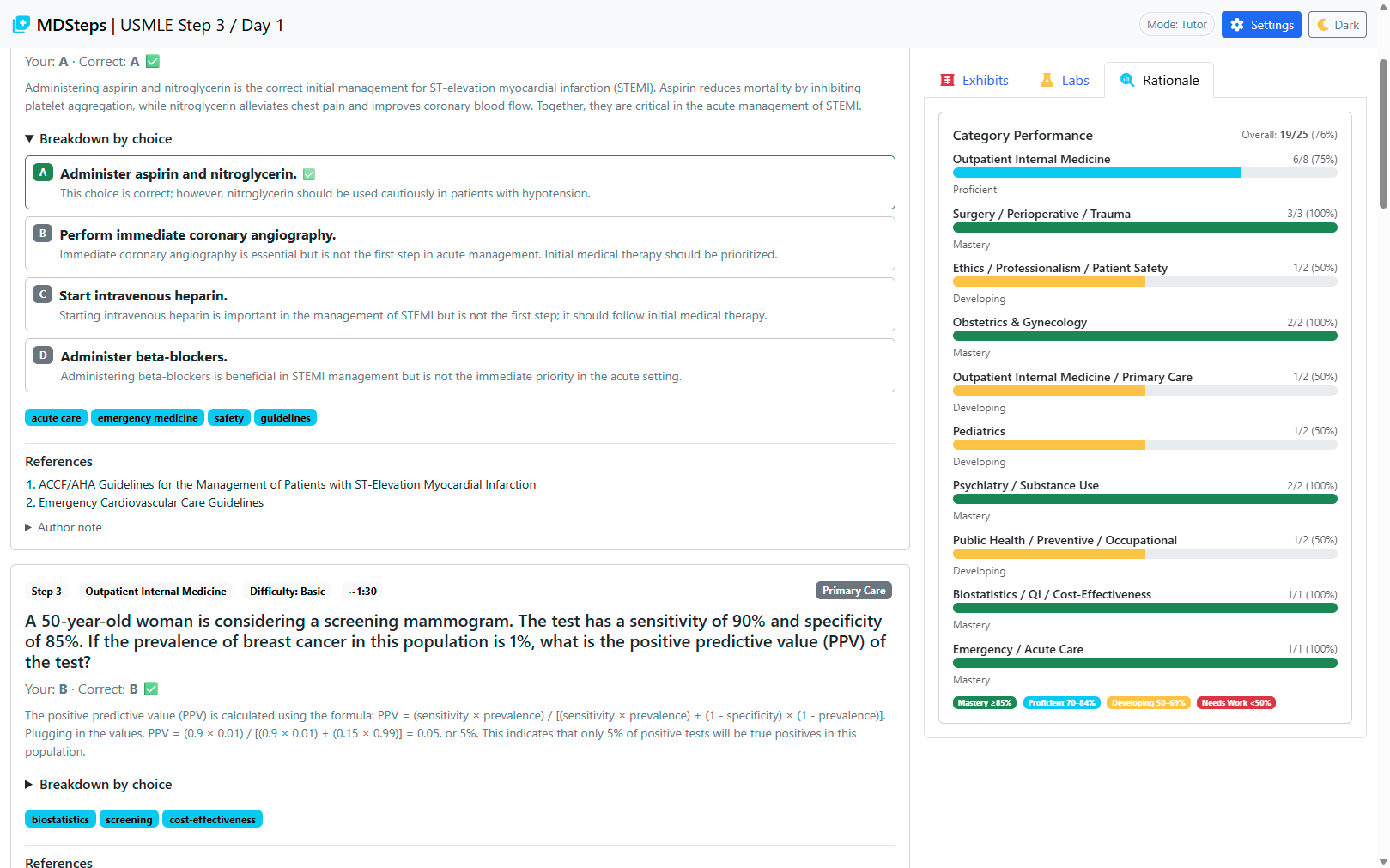USMLE Steps 1–3 • Smart Practice
An Adaptive QBank that trains judgment—not just recall.
MDSteps’s adaptive USMLE question bank calibrates in real time to your accuracy and pacing, targets weak systems and look-alikes, and nudges difficulty to keep you in the learning sweet spot. You’ll build pattern recognition with why-right/why-wrong rationales and pitfall flags—so the how and why stick for the real exam.

Targets growth edges by focusing weak systems and look-alikes, then paces difficulty to maintain engagement.
Concise clinical rationales highlight decision rules and common pitfalls so you remember mechanisms, not trivia.
Misses and low-confidence items return at expanding intervals to convert short-term gains into durable memory.
How adaptation works
The engine estimates your ability (θ) from your answers, predicts the probability of a correct response for each item (logistic model), then selects the next question near your current ability while emphasizing weak systems. Each response updates θ (Elo-style), schedules review if needed, and rebalances content in real time.
—
Smart Review
ScheduledMisses and low-confidence items return at expanding intervals. Review queue updates live as you interact above.
| Item | When | Focus | |
|---|---|---|---|
| No reviews yet. | |||
Readiness Signals
Trendlines combine accuracy, exposure to higher difficulty, and stability (variance). Aim for steady gains with periodic consolidation dips.
Why-right / Why-wrong
Every item delivers rule-in/rule-out cues and pitfalls to harden decision-making. Learn mechanisms, not trivia.
- Rule-in: findings that materially raise the likelihood of the correct diagnosis.
- Rule-out: findings that lower the likelihood of distractors.
- Pitfalls: common confusers and look-alikes called out explicitly.
Pattern recognition that sticks
Our adaptive USMLE question bank continuously tunes item difficulty and content mix based on your performance in real time. It identifies growth edges—the systems and concepts where a little more targeted practice yields outsized returns—and sequences questions to reinforce discrimination between common look-alikes. Clear, concise rationales for both correct and incorrect answers teach underlying mechanisms and guard against common pitfalls. With spaced resurfacing and mixed exposure, you’ll build durable pattern recognition rather than short-term recall.
Whether you are preparing for USMLE Step 1, Step 2 CK, or Step 3, MDSteps keeps your QBank blocks aligned with NBME-style blueprints: systems, disciplines, and clinical presentations. Instead of doing static blocks where every learner sees the same questions in the same order, the adaptive engine chooses questions that match your current ability and fill in your personal blind spots.
This means your study time is spent on the highest-yield tasks for USMLE exam prep:
- Practicing USMLE-style questions at the right difficulty to stretch your knowledge without burning you out.
- Reinforcing missed and low-confidence items through a built-in spaced repetition QBank queue.
- Seeing common clinical look-alikes side by side so you learn to separate similar presentations under pressure.
- Tracking readiness with signal-driven dashboards instead of guessing when to move from content review to test-level practice.
USMLE-style coverage for every Step
MDSteps is built as a single, integrated USMLE QBank that adapts to your stage of training. Whether you are early in basic science, on busy clinical rotations, or consolidating for Step 3, you can use the same adaptive engine to drive focused, exam-level practice.
USMLE Step 1 Question Bank
Reinforce high-yield mechanisms, pathophysiology, biochemistry, pharmacology, and immunology in organ-system blocks. Adaptive sequencing keeps your Step 1 blocks focused on weak basic science foundations while still exposing you to integrated, multi-step vignettes.
USMLE Step 2 CK QBank
Practice clinical reasoning across medicine, surgery, pediatrics, OB/GYN, psychiatry, and emergency care. Items emphasize diagnosis, next best step in management, and test interpretation—mirroring the format and pacing you’ll see on Step 2 CK and NBME shelf exams.
USMLE Step 3 & Early Residency
For Step 3 and early residency, the QBank focuses on multi-day management, ambulatory care decisions, and safety-focused practice. Adaptive resurfacing keeps important long-term management concepts visible as you move through heavy clinical schedules.
How to use the adaptive QBank in your study plan
A powerful USMLE question bank only works if it fits into your schedule. MDSteps is designed so that you can plug it directly into a dedicated study period or a busy rotation month without overhauling your entire routine.
- Start with daily mixed blocks. Run 20–40 mixed questions per day so the adaptive engine can calibrate your baseline and identify weak systems.
- Layer targeted practice. Once you see clear weak areas (e.g., renal physiology, OB triage), add focused blocks while keeping at least one mixed block per day to maintain global readiness.
- Protect your review time. Use the built-in spaced resurfacing queue to drive rapid, targeted reviews of missed and low-confidence items instead of scrolling through long correct/incorrect lists.
- Watch readiness signals. As your composite readiness score climbs and stabilizes, start incorporating more timed, exam-length blocks to simulate test day.
Used this way, MDSteps becomes more than just another QBank—it becomes the backbone of your USMLE prep strategy, continually adjusting the questions you see so you can focus on thinking like the exam, not just memorizing facts.
Adaptive QBank — Common Questions
Master your USMLE prep with MDSteps.
Practice exactly how you’ll be tested—adaptive QBank and clarity from your data.
- Adaptive QBank with why-right/why-wrong rationales
- Spaced resurfacing with smart scheduling
- Progress dashboard with readiness signals